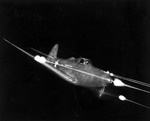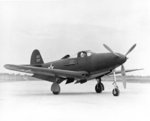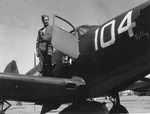P-39 Airacobra
| País | Estados Unidos |
| Fabricante | Bell Aircraft Corporation |
| Função Principal | Caça |
| Primeiro Voo | 6 abr 1938 |
Contributor: C. Peter Chen
ww2dbaseIn Feb 1937, United States Army Air Corps Lieutenant Benjamin Kelsey issued a request for a new heavily armed, high performance, high altitude, single seat fighter. The manufacturer Bell took a new approach to fulfill this request. Instead of the usual manner of designing an aircraft around a suitable engine, Bell engineers designed this aircraft around its heavy weapons. This resulted in the engine being located in the center of the aircraft just behind the cockpit which drove the propellers through a shaft 10 feet in length that ran in the cockpit floor. This configuration freed up the nose to house the heavy weapons that the Army had called for, which included a 37-millimeter T9 cannon. Because of this design, space for fuel storage was limited, thus this aircraft was to serve in short range missions only.
ww2dbaseThe prototype aircraft XP-39 took flight on 6 Apr 1938 at Wright Field, Ohio, United States. Impressed with its ability to reach 630 kilometers per hour at the altitude of 6,100 meters in under 5 minutes, the US Army placed an order for 12 YP-39 prototype aircraft for further testing. On 10 Aug 1939, an order for 80 production aircraft, at this time designated P-45, was placed; the designation would change back to P-39 before the delivery of the first aircraft.
ww2dbaseIn Sep 1940, the British Royal Air Force ordered 386 P-39D Airacobra fighters. The order number would later increase to 675. The first fighter arrived to the No. 601 Squadron RAF on 6 Aug 1941. The British pilots found the performance inadequate, especially at high altitudes. This was caused by the lack of turbo-superchargers, something equipped in the prototype but was removed from the design right before the design entered production. Also, the prototype lacked the heavy armor that was equipped in production models. On 9 Oct 1941, No. 601 Squadron RAF mounted a mission with four P-39 aircraft, targeting German barges near Dunkerque, France. This mission was to be the last operational mission with P-39 aircraft for the RAF. In Mar 1942, the squadron was re-equipped with Spitfire fighters. Ultimately, the RAF only retained 80 P-39 fighters for its own use, transferring the other 200 that it had received to the Soviet Union.
ww2dbaseWhen WW2 began for the United States in Dec 1941, the first operational squadron equipped with P-39 Airacobra fighters was 39th Pursuit Squadron of 31st Pursuit Group, based at Selfridge Field in Michigan, United States. Many of the American pilots had similar negative opinions as their British counterparts in regards to the P-39 design, and as a result several US P-39 squadrons based in Britain were re-equipped with Spitfire V fighters instead. 200 P-39 Airacobra fighters, re-designated P-400, were sent to the South Pacific. P-39 Airacobra fighters (specifically, P-39D variant) saw their first combat against the Japanese over New Guinea island, with pilots of 8th Fighter Group in the cockpits. Later in the war, in Feb 1944, the Tuskegee African-American pilots were assigned P-39 aircraft during the Italian campaign; after supporting the landing operations at Anzio and raiding German and Italian shipping, they were replaced by P-47 Thunderbolt and P-51 Mustang fighters in Jun and Jul 1944, respectively. USAAF Lieutenant Bill Fiedler became the only American to become an ace with the P-39 Airacobra fighter.
ww2dbaseA total of 4,924 P-39 fighters were allocated to the Soviet Union, of which 4,758 safely made it to their destinations. Soviet Air Force pilots discovered a problem with P-39 Airacobra fighters in which the aircraft could enter dangerous flat spins when the aircraft was improperly loaded, i.e. not enough weight in the front of the aircraft. Bell did not have a solution for this problem other than stressing the importance of proper weight distribution. Despite of this issue, Soviet pilots appreciated these fighters for their air-to-air combat capabilities, particularly regarding the 37-millimeter T9 cannons that could inflict heavy damage to enemy aircraft with only a few shots. While British and American pilots complained of the inadequacies in high altitudes, Soviet pilots found this characteristic to be of little concern, as the war in Eastern Europe required fewer high altitude operations. Soviet pilot Nikolai G. Golodnikov noted:
ww2dbaseMany Soviet pilots, including Aleksandr Pokryshkin and Grigori Rechkalov, reached ace status while flying P-39 Airacobra fighters.
ww2dbaseThe Royal Australian Air Force received used American P-39 Airacobra fighters in Jul 1942 as a measure to quickly bolster the Australian air defense capability. None of them saw combat before the P-39 fighters were replaced by better performing aircraft.
ww2dbaseBetween mid-1943 and late-1944, Free French forces operated some P-39N and P-39Q fighters, based in North Africa. They were replaced by P-47 Thunderbolt fighters in the latter part of the war.
ww2dbaseIn Jun 1944, as a part of the Allies after the fall of Benito Mussolini's government in 1943, Italy received 170 P-39 fighters. 149 of them were used by the Italian Air Force, some for front line service while others were retained for training missions only. After the war, Italy purchased 46 surviving aircraft from the US at an inexpensive price and kept them in service until 1951.
ww2dbaseProduction for P-39 Airacobra fighters ended in Aug 1944. By this time, 9,558 aircraft were built, about half of which, 4,773, were sent to the Soviet Union. 7 of them were delivered to the US Navy for the development of radio-controlled drone aircraft. On 13 May 1940, a naval prototype of the design took flight under the designation XFL-1 Airabonita; it was eventually rejected thus never entered production.
ww2dbaseSources:
Robert Dorr, Fighting Hitler's Jets
Wikipedia
Last Major Revision: May 2010
P-39 Airacobra Timeline
| 6 abr 1938 | P-39 Airacobra took its first flight at Wright Field, Ohio, United States. |
| 10 ago 1939 | P-39 Airacobra fighter entered production with a US Army order for 80 aircraft. |
| 6 ago 1941 | The first Bell Airacobra fighter arrived in the United Kingdom. By the end of Sep 1941, eleven machines had been received by No. 601 Squadron RAF, but during trials by the Air Fighting Development Unit at Duxford it was found that the much publicised performance figures claimed by the manufacturer were much overrated (having been obtained by a highly polished machine weighing a ton less than the production aircraft delivered to the RAF). The maximum speed for example being some 33 mph slower than anticipated and, although pleasant enough to fly, was definitely inferior to the Hurricane and Spitfire in climb rate and ceiling. |
| 9 out 1941 | No. 601 Squadron RAF mounted a mission with four P-39 Airacobra aircraft, strafing German barges near Dunkerque, France. This was to be the final Airacobra mission with the RAF. |
| 25 jul 1944 | Production of P-39 Airacobra fighters ceased. |
SPECIFICATIONS
P-39Q
| Machinery | One Allison V-1710-85 liquid-cooled V-12 engine rated at 1,200hp |
| Armament | 1x37mm M4 cannon, 2x12.7mm M2 machine guns, 4x7.62mm M1919 machine guns, optional 230kg bombs |
| Crew | 1 |
| Span | 10.40 m |
| Length | 9.20 m |
| Height | 3.80 m |
| Wing Area | 19.80 m² |
| Weight, Empty | 2,425 kg |
| Weight, Loaded | 3,347 kg |
| Weight, Maximum | 3,800 kg |
| Speed, Maximum | 605 km/h |
| Rate of Climb | 19.00 m/s |
| Service Ceiling | 10,700 m |
| Range, Normal | 840 km |
| Range, Maximum | 1,770 km |
Photographs
 |  |  |  |
Você gostou deste artigo ou achou este artigo útil? Se sim, considere nos apoiar no Patreon. Qualquer valor já vai ajudar! Obrigado. Por favor, ajude-nos a divulgar o site: Fique atualizado com WW2DB: |
Visitor Submitted Comments
13 May 2010 12:00:06 AM
я-авиамоделист-копийст по моделирования масштаба Аэрокобра П-39.Пожалуйста и спасибо
27 Apr 2019 08:17:48 AM
Ground crew found the P-39’s Allison engine fiendishly difficult to work on. They commonly had to strip off several fuselage panels and often had to remove the rear cockpit canopy, the pilot’s seat and the back armour too, in order to carry out even routine servicing. More seriously it proved impossible to fit anything other than a very basic single-stage single-speed supercharger that made the type sluggish at altitudes above 17,000 Feet.
3 Jan 2022 07:45:20 PM
Better check your range numbers on your specifications. There in no way A P-39Q can achieve that range even with a 75 gallon drop tank!
3 Jan 2022 08:46:20 PM
Joe Morales (above):
Thank you for prompting us to double-check our stats and we have. According to the 1943 Bell Aircraft P-39Q-1 operating instructions, the range of the P-39Q was 1,100 miles, or 1,770 km. It is not stated what fuel capacities were necessary to achieve that range, but that is what it said. http://www.wwiiaircraftperformance.org/P-39/P-39Q-1_Operating_Instructions.pdf
4 Jan 2022 09:35:34 AM
David - thank you for the quick response. I have a copy of the operating instructions and the only way a P-39Q can achieve a 1,100 mile range is with a 147 gallon auxiliary tank which was not commonly used in combat operations. With a 75 gallon drop tank the best range shown under perfect circumstances for a P-39Q, take off weight 8,100 pounds is 690 miles cruising at 15,000' at 170 MPH Indicated which would had been insane to do in a combat zone. Reference the cruise chart on P25. Thank you!
All visitor submitted comments are opinions of those making the submissions and do not reflect views of WW2DB.

» Kelsey, Benjamin
» Pokryshkin, Aleksandr
- » 1,181 biografias
- » 337 eventos
- » 45,111 entradas na linha do tempo
- » 1,247 navios
- » 350 modelos de aeronaves
- » 207 modelos de veículos
- » 376 modelos de armas
- » 123 documentos históricos
- » 261 instalações
- » 470 eventos
- » 28,476 fotos
- » 365 mapas
Thomas Dodd, late 1945
Por favor, considere nos apoiar no Patreon. Mesmo R$1 por mês já faz uma grande diferença. Obrigado!
Ou, por favor, nos apoie adquirindo alguns produtos do WW2DB na TeeSpring. Obrigado!
13 Dec 2008 01:46:09 PM
Quick comment: T9 was the designation of the prototype version of this gun, the production version was designated M4. The P-39 was designed as a bomber interceptor equipped with a large-calibre cannon, and that dictated the unusual configuration.